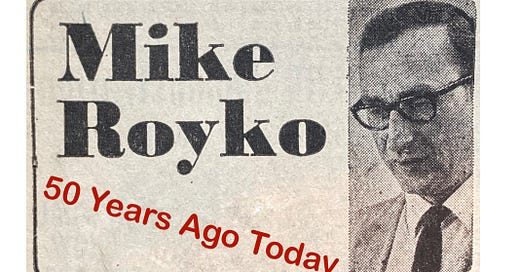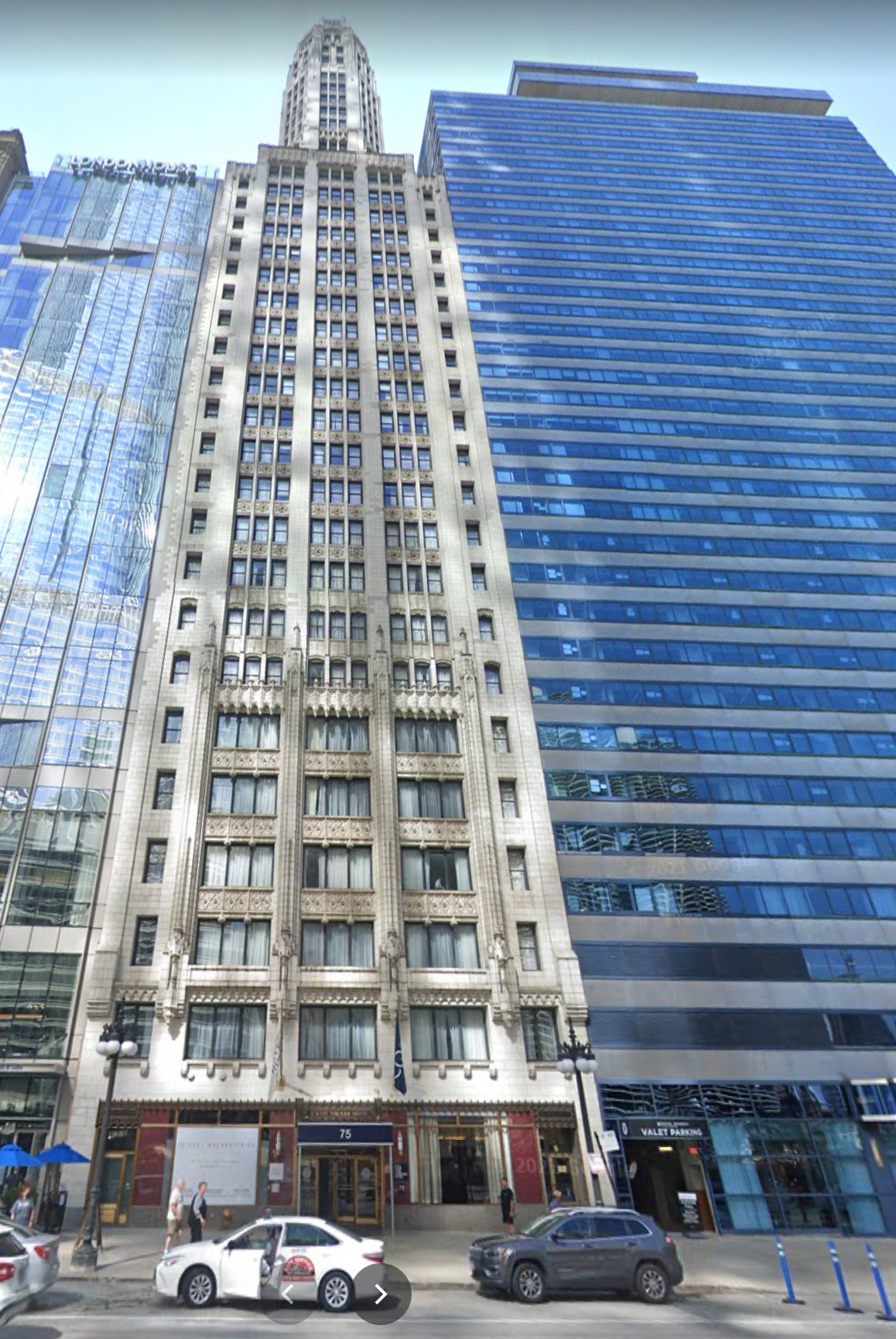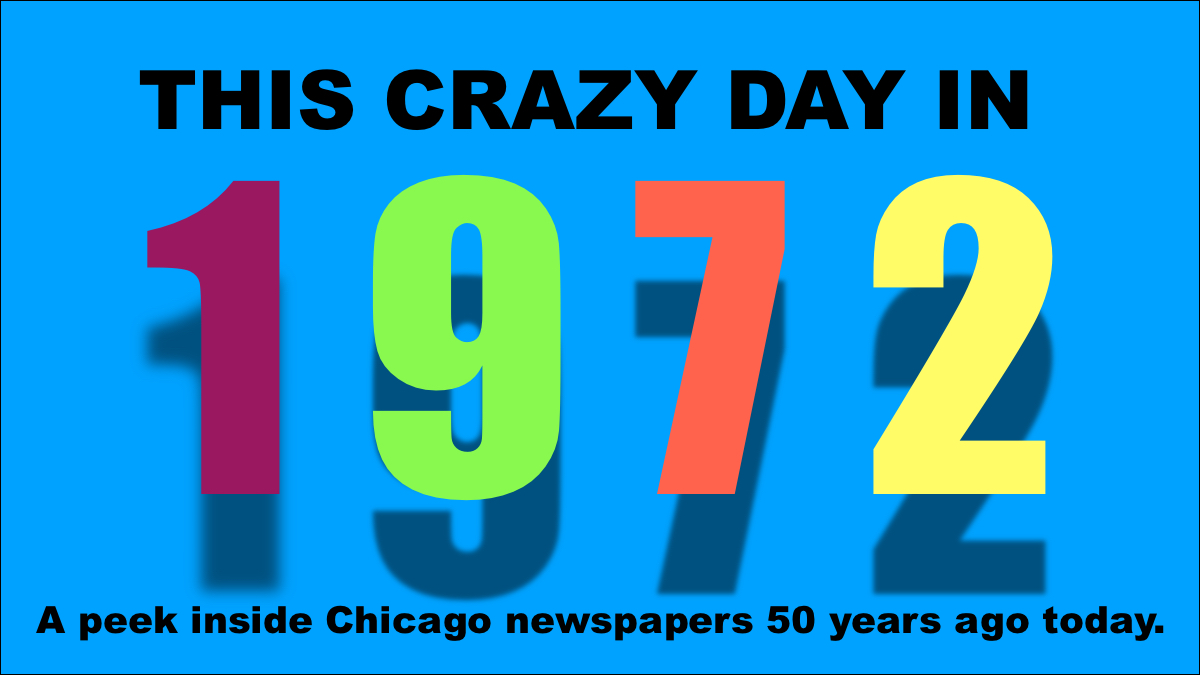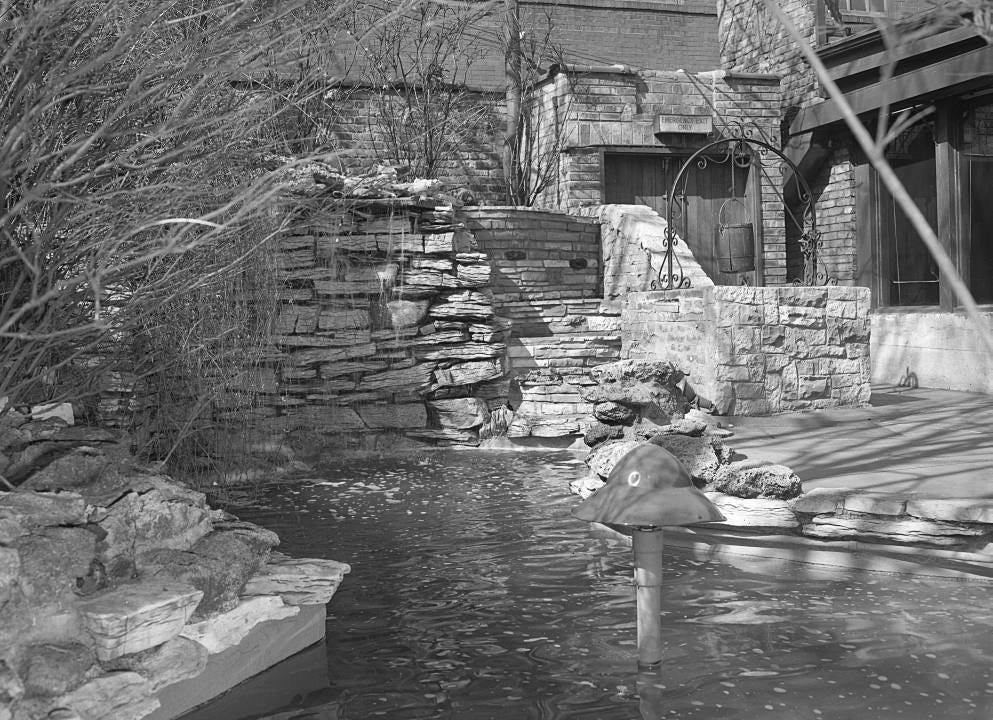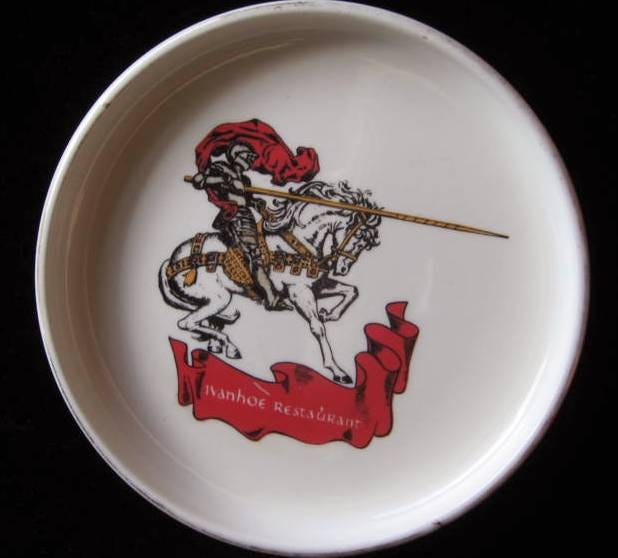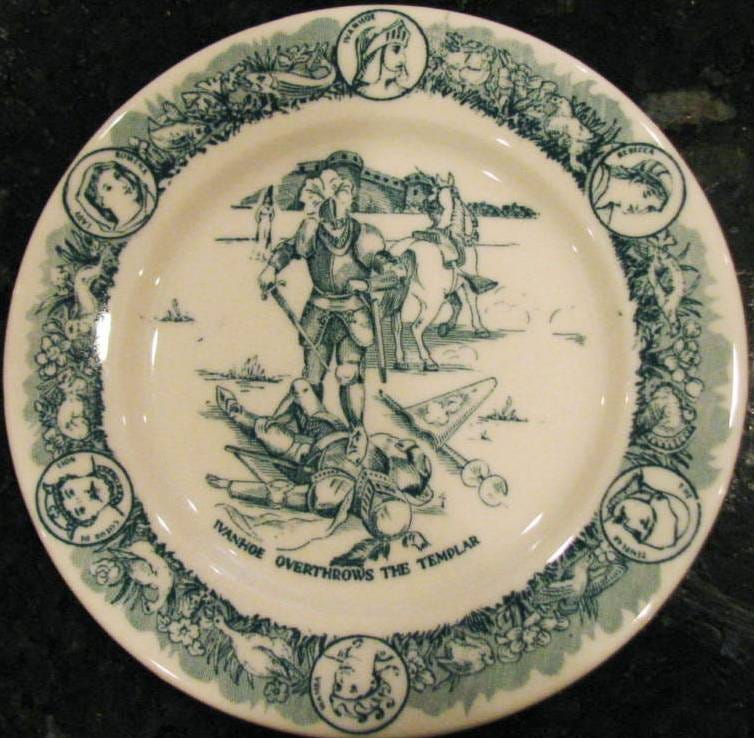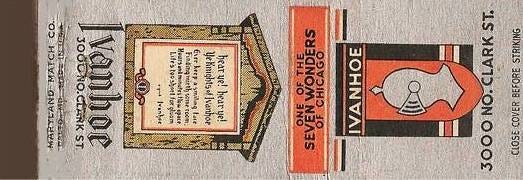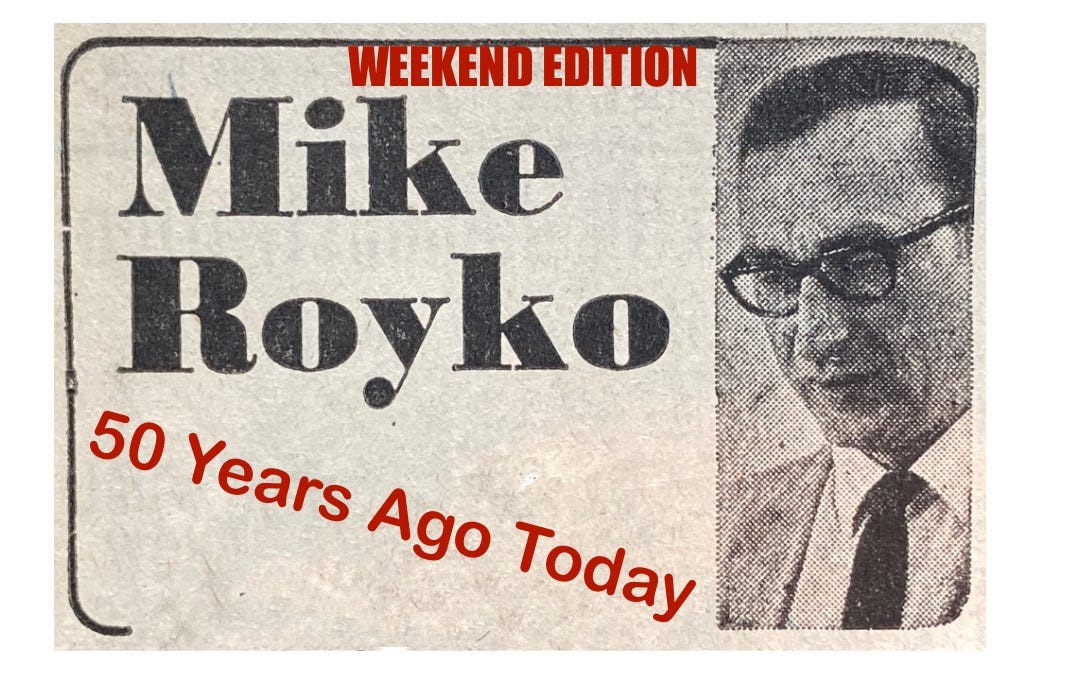Mike Royko 50 Years Ago Today: Matzoh pancakes and the Ivanhoe Restaurant
Weekly Compilation April 10-16, 1972
To access all site contents, click on the rose icon in the upper left corner or HERE.
Why do we run this separate item, Mike Royko 50 Years Ago Today? Because Steve Bertolucci, the hero of the serialized novel central to this Substack, “Roseland, Chicago: 1972,” lived in a Daily News household. The Bertoluccis subscribed to the Daily News, and back then everybody read the paper, even kids. And if you read the Daily News, you read Mike Royko. Read the daily Royko briefing Monday-Friday on Twitter, @RoselandChi1972.
April 10, 1972
Mike Chosa a bit choosy
A group of 30 to 100 Native Americans—Indians, in the parlance of 1972—has been occupying and being evicted from a succession of Chicago area spots since 1970. They’re led by Mike Chosa, and call themselves the Chicago Indian Village.
The Indians began with sit-ins at the Chicago office of the Bureau of Indian Affairs, protesting the amount of aid from the bureau. The bureau’s director told reporters, including a young Pamela Zekman with the Tribune, that the bureau’s mandate was limited to temporary three-year assistance for Indians moving from reservations to the city—though he admitted the monthly stipend for newly relocated Indians was below the poverty line.
The group switched to live-in occupations after Carol Warrington was evicted with her six children from her $90/month apartment at 3717 N. Seminary for nonpayment of rent. Warrington set up an Indian teepee in front of the building first, which was soon moved to a dirt lot across the street on Milwaukee Railroad land. Val Christmann leased the railroad land for Wrigley Field parking. Christmann told the Indians they could use the space temporarily on one side of the railroad tracks where he didn’t park cars, but the Indians added more tents and expanded into the other side. Complaining about portable toilets and garbage too after a few weeks, Christmann wanted the Village to leave.
Mike Chosa met with Chicago’s Department of Human Resources director and refused an offer of housing for the then 60 village residents. The Indians eventually left the parking lot, moved into a building at 1142 W. Ainslie that was under court order for demolition, and began the cycle anew. Thus began an odyssey that continued into 1972.
“It’s hard to believe, but this has been going on for almost two years,” writes Mike today.
At this point in 1972, the Chicago Indian Village has overstayed an agreed sojourn period at the Illinois National Guard’s Camp Logan near the Wisconsin border. The National Guard needs its barracks back for recruits scheduled for training.
“First, it was that tent village set up by Indians near Wrigley Field in May, 1970,” Mike writes, quickly listing subsequent locations from which the Chicago Indian Village has been evicted—the basement of the Fourth Presbyterian Church, the recently closed Nike missile base near Belmont Harbor, a Methodist summer camp in Naperville, the gate of Fort Sheridan. He left out the closed Nike missile base at Argonne National Laboratory, and a subsequent week camping out in cars.
“But before you begin cursing the memory of Gen. Custer, you might be interested in knowing something about the housing Chosa has been rejecting these two years,” writes Mike. “To hear Chosa tell it, he has been offered nothing but tarpaper shacks or rat-infested slums.
“The truth is most of the apartments were in decent, clean, well-maintained buildings that charged reasonable rent.
“Most of them are on the North Side, within walking distances to the lakefront and public transportation.
“If they weren’t luxurious, they were much better than the apartments occupied by tens of thousands of other Chicagoans.”
Mike notes that Chosa also refused some housing offers that didn’t let the group live together, but he concludes that Mike Chosa needs to realize he’s looking for apartments in Chicago.
“About the best you can hope for here is hot and cold running water, a furnace that works in the winter and landlord who keeps the place in shape and doesn’t gouge you on the rent,” Mike concludes.
Is Mike unreasonably dismissing the Chicago Indian Village’s demands? It would be easy to assume he’s insensitive. His language is certainly insensitive to 2022 eyes and ears. Many will be offended today by a reference like the General Custer line and look no further, regardless of whether Mike Chosa and his followers should have accepted any of their numerous housing offers. For these people, the complicated story of the Chicago Indian Village won’t matter.
For those willing to consider the different language standards of 1972, I can only say the case of the Chicago Indian Village is tangled indeed. After spending much time going over it, I’m still not sure what to think.
If you only listened to Studs Terkel’s interview with Mike Chosa during the occupation of the shuttered Belmont Harbor Nike missile base, for instance, you’d probably be convinced that the Indians should have been granted their demand at that point, which was for 200 housing units and a cultural center located there on the lakefront. At that time, the base had just closed, and the city and Park District were holding public hearings on how to redevelop the site.
Studs sits in a car with Chosa at close to midnight on a foggy summer night, the sound of Indian drums and dancing teenagers in the background, and the lights of the lakefront highrises across Lake Shore Drive blurred through the fog. Studs revels in the scene, often calling admiring attention to the “young Indians” nearby. Meanwhile, Chosa delivers many colorful comments in a rambling talk, including the need for people to appreciate nature, how highrises block the sunlight— “they are like monsters to us”—and how the city and modern society have ruined “your religion,” meaning Christianity. Really, if you stopped random people on the sidewalk then or today, most would agree with all of that.
But the question wasn’t whether people—in this case Indians—need culture, structure and nature in their lives. The answer to all of that is yes. The question was how the government should have responded to the Indians’ specific housing demands.
Studs’ interview with Mike Chosa is a good example of how complicated this story is. The interview was broadcast on June 17, 1971, portraying the Chicago Indian Village occupation of the missile site as an idyllic fight for human rights. A week later, Mike Chosa told the Tribune’s Stanley Ziemba that his group members were both fighting and drinking out of control, including teenagers as young as 13. Because of the extended direct quote, it’s hard to see how Ziemba could have taken Chosa’s comments out of context:
“If the drinking doesn’t stop soon, our entire campaign will be destroyed. I’m begging my people to get together. The young people especially have to realize we’re here for a purpose. This isn’t a party.
“I have an Indian police force of 17 men in the village who were assigned to keep order and prevent people from bringing liquor into the camp, but most of them are drinking along with everyone else.
“The drinking began the day we took over the missile site and it has been getting worse right along. I’ve tried to tell the people to stop but they won’t listen to me.”
Did reporter Ziemba make those quotes up out of whole cloth? Even for the Tribune, it seems unlikely, especially by 1972. The situation sure doesn’t sound like a good one for the children.
Mike Royko was friends with Studs Terkel, and it’s hard to figure he wouldn’t have discussed this issue with Studs over the course of two years. Wouldn’t you love to know if they argued about it?
Reading over the raft of Tribune articles covering the two-year odyssey, I assumed always that the Tribune wasn’t giving the Indians the best spin and that government officials were never as helpful as they want to appear. But it was still hard not to conclude that Mike Chosa was probably a well-meaning but confused leader of a confused group.
Overall, Chosa and his group established a definite pattern that no spin from the Tribune could change. The group generally got permission to occupy different places for an agreed time period; they would refuse to leave on time; and when they did exit, they would leave behind piles of garbage and unused donated food and clothing. Those facts seemed reliable.
At each phase, different officials offered the group housing in the form of private or CHA apartments. Mike Chosa would insist the housing didn’t really exist, was not good enough, or failed to keep the group together in one place. So the question comes down to whether any of the offered housing was reasonable. Let’s assume none of the housing options were top-notch. I still had to wonder, were none of them still better than dragging the group’s children through an endless trek without a stable home or schooling? Mike specifically mentions one of the recent options, apartments at 1448 N. Sedgwick, then called the Town and Gardens Apartments—with reasonable rent, large living rooms and 24-hour security. That complex has always looked well-kept to me, and you can’t beat the location.
While the Chicago Indian Village was overstaying its allowed time at the Methodist summer camp in Naperville, Dr. Rita Goldman, a professor from North Central College, set up a school aided by some of her students for the approximately dozen Indian children. Goldman told the Tribune most of the kids were “deeply, emotionally disturbed and needed some sort of help.” Was she correct, or overstating the case? Given the situation, it’s hard to imagine that the kids would not have been affected.
Also, some other Indian groups denounced Chosa’s people for misrepresenting Indians in general, and for sucking up all the media attention around the specific issue of needy people in Uptown. A petition signed by 275 members of 45 tribes claimed that Chosa’s group was giving a “distorted picture of Indian life and Indian needs in Chicago”. One Indian spokesman seeking donations for the needy in Uptown grumbled that maybe they should follow around the Chicago Indian Village and pick up the donated food and clothes they left behind every time they moved on.
Tribune columnist Terri Schultz covered the original Village near Wrigley Field, and later the Belmont Nike missile site. Reporting from the original Village, Schultz noted that the Village residents complained about the American Indian Center in Uptown—while “Employes of the Center privately feel the Villagers are lazy and perpetuating the image of the ‘no-good drunken Indian.’ Those in the Village accuse the Center of harboring ‘apples’--Indians who are red on the outside and white on the inside.”
This is the confusing, ongoing story Mike addressed today, as the Chicago Indian Village continued its two-year pattern by refusing to leave Camp Logan.
Since the answer seems to me not at all clear-cut, I wouldn't automatically say I disagree with Mike’s conclusion: Mike Chosa should have accepted a housing solution. But I do wish Mike had approached the issue differently. I wish he had gotten together with Mike Chosa and talked, the way he does later this week with Lonny Murphy for his April 13 column. Mike may well have come away with the same opinion--that Mike Chosa should have accepted some of the housing offered to him over the course of two years--but we readers could feel more confident that he’d fully assessed the situation.
April 11, 1972
The charge: culinary usury
“One of the more dramatic price battles being fought during Phase I involves Harry Barnard, the author-biographer, and Lenny Minck, who owns several downtown restaurants,” Mike opens today.
Before we go any further, background:
Chicago, like the entire country, is obsessed with inflation at this point in 1972, particularly as it relates to food. So much so, a Republican president, Richard Nixon, put price controls in place and created agencies that sound like they’re straight out of the New Deal.
To put the wonder of that in context, let’s briefly remind ourselves that the New Deal was/often still is roundly and ferociously hated by Republicans. The Tribune’s very Republican owner and publisher during that time period, Colonel Robert McCormick, literally believed that Franklin D. Roosevelt was a Communist--and even Herbert Hoover was “the greatest state socialist in history.”
Nixon’s federal price controls don’t affect fresh food like produce and meat. As those basic commodities grow more expensive, however, prices for processed food created with those commodities slowly go up too, constricted by government rules. So cucumbers get really expensive fast, while pickles slowly get a little more expensive all the time.
Every Chicago newspaper is currently full of articles every single day about inflation, particularly relating to food. Inflation is up this much, this expert says this about inflation, here’s why this or that price increased again—and in case you forgot how, here’s some tips on shopping and cooking from scratch like every American did just 20 years earlier when grocery stores weren’t full of processed convenience foods.
Since people need to eat more (and more often) than they need new TVs, grocery store trips are especially fraught, and that gets a lot of newspaper attention. I don’t include a lot of these articles in THIS CRAZY DAY IN 1972 because they are, of course, boring.
I just want to note here that it took Mike Royko to find an entertaining spin on the then-ubiquitous topic of food inflation. And I don’t want to unnecessarily pile on Chicago Today columnist Jack Mabley, who in leaving the Daily News created an opening that was miraculously filled by Mike Royko. But I’m afraid Mabley gives the perfect example this week of the dreary grocery coverage that Mike nimbly leaps past in his own column today. The contrast is worth highlighting.
From Mabley’s April 14 column of reader letters and his own comments:
“Thought you’d be interested in passing a few more ideas to your wife or readers,” writes Mrs. Lorr Nalenzy. This is not Mabley’s first foray into grocery and cooking coverage. “I buy the flat bone (blade cut) pot roast on sale for anywhere from 45 to 60 cents a pound. I usually buy 5 to 10.
“I cut them up, grind some, and make Italian beef sandwiches, chop suey, beef stew, beef soup (all bones used in this), meat loaf, meat balls, hamburgers, stuffed peppers, stuffed cabbage, beef-noodle casserole, beef-brown rice casserole, and tie up some and make a roast.”
And from Mrs. M.E.B. of Chicago: “I picked up a cantaloupe and read the price. Would you believe, 72 cents! A year ago they were selling for 39 cents. I put it back and bought a pack of cantaloupe seeds.”
Jack’s comment: “Mrs. Nalenzy sent a flock of other ideas I’m sorry I don’t have space to print.” Thank God for that, even though I find Mrs. Nalenzy’s letter fascinating from an anthropological 50-years-later perspective. And in all fairness, that cantaloupe cost $4.86 in 2022 money, so yeah—Mrs. M.E.B. was right to put it down.
Back to Mike and today’s subjects, Harry Barnard and Lenny Minck. You will actually wish a recipe was included with this, but that’s not how Mike rolls.
Harry Barnard, as Mike mentions in the lede, was an author and biographer. His most well-known book is a biography of Illinois Governor Peter Altgeld, famous (but too infamous to re-elect in his time) for pardoning three of the men convicted for conspiring to throw the bomb that killed eight Chicago policeman at Haymarket Square in 1886. The book was a strong contender for the Pulitzer. Barnard’s papers are at both the Jimmy Carter and the Harry Truman Presidential Libraries. Barnard earned a Ph.D. from the University of Chicago, and then went to John Marshall Law School. With all that eduction, he still went into newspapers.
According to Barnard’s bio at the Jimmy Carter library website, he “worked on the editorial staffs of the Chicago Herald Examiner (1929-1935) and the Chicago Times (chief editorial writer, 1944-45) and was an occasional member of the editorial staffs at the Chicago Sun and the Detroit Times. He was the author of a syndicated column ‘Liberal at Large’ that appeared in the Chicago Daily News and other newspapers in 1958-60.”
That means Barnard was a Chicago journalism contemporary of Ben Hecht, and he worked at the notorious Hearst Herald-Examiner during its most outrageous years. Barnard must have met Royko from general journalism circles, or through the Daily News. Here’s a 1967 Studs Terkel interview on WFMT with Barnard discussing “life as a teacher, writer and biographer”.
Unfortunately I was able to come up with much less information on Lenny Minck. Lenny’s father, David Minck, began the family restaurant business. David had a restaurant at 1412 W. Morse at least through 1956, when it suffered a fire.
Here’s the site now, just west of the L. The restaurant used to be on the ground level where the current store front is topped by new apartments.

David Minck died at 62 in February 1963 in Miami Beach. According to his Tribune obituary, “He was a resident of Chicago until six months ago and founder of Minck’s restaurant at 180 W. Randolph Street.” So it sounds like David Minck put his son Leonard (Lenny) in charge and retired in fall of 1962. He moved to Florida, and sadly died within six months. There is no information on when the Mincks started their restaurants in the Loop, though going by the obituary and newspaper ads, the Randolph St. location must have been first, and was firmly established in 1963.
That first Minck Loop restaurant was probably in the western most corner of the ground floor of the Michael A. Bilandic Building (named for the former one-term mayor and later judge), at the northwest corner of Randolph and LaSalle. Or, it may have been in a now-demolished building next door, currently a small open parking lot. The Bilandic Building was built in 1920, originally as the State of Illinois Building. It’s kitty corner from City Hall, and directly across Randolph from the Cadillac Palace Theater. Time was getting away from me, so I only had a chance to try to ascertain this via Google Streetview. It would help if more doors had street addresses on them.
Mostly from ads, we can say that in 1972, Lenny Minck still owned the Randolph restaurant, called variously “Lenny Minck’s” or just “Minck’s,” plus another Lenny Minck’s at 75 E. Wacker, and yet another at 213 S. Wabash.
Thanks as always to Google Streetview, here’s the only extent building to house a Minck’s restaurant, 75 E. Wacker, between Michigan and Wacker. Patrons would have looked out across the river directly at the Sun-Times Building (now Trump Tower) and for those sitting in chairs looking west, they would have watched the IBM Building and Marina Towers being built.
The Wacker and Wabash restaurants don’t show up in ads until the late ‘60s, so we can made the educated guess that Lenny extended the family business after he took over from his dad in 1962. However, Lenny had sold his business by 1974, when a long advertorial for Tralee-Farm Restaurant in Barrington Hills notes that that establishment’s “hosts” also own Lenny Minck’s at 178-80 W. Randolph. It’s an odd combination, since Tralee-Farm—now also gone—was a high-end place set in a large former private home with bucolic grounds.
There is a single article in the Tribune that mentions Lenny Minck’s, an installment of a regular column called “Out to lunch.” In this 1968 column, “Out to lunch” reviewed Loop restaurants where you could also buy groceries to take home. Here’s the cute column logo, which even has the “Out to lunch” business card lined up to the correct month and year on the pictured desk calendar. That surprises me, since it means they updated the logo every four weeks.
Minck’s, 213 S. Wabash av, which features a delicatessen counter with a wide range of foods besides the various bakery items.
The restaurant area has two seven-seat counters and several booths and tables. Among the items listed on the enormous bill of fare are fried matzos, $1.10; sweet and sour meatballs, $1.75; and sauteed chicken livers, $1.35. I had a bowl of chicken kreplach soup, 45 cents, and a kishke, 50 cents, which were quite good.
Minck’s hours are 7 a.m. to 8:30 p.m. Monday thru Friday, and 7 a.m. to 7 p.m. Saturday.”
Here’s 213. S. Wabash today, the nicely landscaped southeast corner of Adams and Wabash that now hosts Opus Restaurant and Cafe.
And now, finally, to Mike’s column. The 1972 rampant inflation has flung together the explosive combination of entitled brainy author Harry Barnard and no-nonsense restauranteur Lenny Minck, who we can safely assume grew up working the cash register, busing tables and everything in between at his dad’s restaurant on Morse, just west of the L tracks.
Just for fun, let’s imagine Harry Barnard going into the Minck’s at 75 E. Wacker and looking at the Sun-Times Building as he eats.
As Mike reports:
“Barnard has filed an official complaint with the federal government, accusing Minck of charging too much for a plate of matzoh pancakes during Passover.”
Barnard filled out Federal Form S-7 (11-71) which replaced form OPE 400, which went to Conrad Clapper, “program manager for Chicago price stabilization”. As noted at the start, it sounds like 1942.
According to Barnard’s complaint, “I was given four pancakes, diameter about 3 inches, with a small dish of apple sauce. To my astonishment, I was billed $1.65 for the four pancakes and apple sauce.
“I believe such a charge to be unconscionably unreasonable. My wife could serve such an order for a total cost of 22 cents…It makes it impossible for people of ordinary means to lunch in Chicago’s Loop, if such usury is permitted to be general.”
Just have to say, I doubt Mrs. Barnard could serve her husband pancakes for 22 cents if they lived on the ground floor of a commercial building in the Loop. Also, Lenny Minck points out that he puts free dishes of pickles and sauerkraut on every table. Does Mrs. Barnard do that? Barnard’s $1.65 bill is $11.14 in 2022 money, not an unusual amount to spend on lunch in the Loop today, while 22 cents is $1.48. You can’t even get a tall plain coffee at Starbuck’s for that. If you ordered a tall coffee at the Starbucks at 55 E. Jackson, you’d pay $2.85—42 cents in 1972 money.
We don’t know for sure which Minck’s served Barnard his matzoh pancakes. As I’ve noted before, Mike is sometimes unusually vague on such details for no apparent reason. Why not specify where this happened?
Clearly, Barnard brought his complaint straight to friend/former work colleague Mike Royko after filing it with the city. Lenny Minck knew nothing about the whole thing until Royko called him up about it. I wonder how Mike played it. Maybe he knew Lenny Minck too and the whole thing was a big joke to both of them. Or Mike didn’t know Minck, but his approach made it clear that he, Mike Royko, thought the whole thing was silly. But I’m thinking a restauranteur might not like this kind of publicity even if a pal was writing it up. So Minck could have been truly annoyed by the whole thing, whether he knew Mike or not.
“What is he, some kind of crank?” Mike quotes Lenny. “The price is posted on the window. Everybody raves about our matzoh pancakes. It’s my dear old mother’s recipe. She’s still alive, almost 80, and it’s one of the finest.”
“Barnard responded: ‘You tell Minck that I had a lovely Jewish mother, and she made even better ones, and they didn’t cost that much. And my wife says she can make them for 22 cents.’”
Mike has a great time hanging up the phone on one guy and then calling back the other to report every retort. Eventually, Lenny Minck uses the classic line, “It takes one to know one.” Can’t you just hear it?
Back to the New Dealish bureaucrat overseeing Chicago price stabilization, Conrad Clapper.
“Clapper said his office will determine if the price went up by more than 2 ½ percent since Nov. 14,” writes Mike. That would adhere to current Nixon administration price controls. “If not, the matter will be closed. Told this, Minck said: ‘Ha. The price has been the same for three years.’”
Barnard plans to write both Illinois U.S. senators about this outrage. Minck finally tells Mike he’ll give Barnard a plate of free pancakes.
“Told of the offer, Barnard said: ‘I have found another place. They only charge $1 for matzoh pancakes.’
“To which Minck snapped: ‘Good. Then let him eat there.’”
And now, we have finally spent enough time chewing over a plate of pancakes from 1972. They were delicious.
If you dig Mike Royko, you’ll want to see the news he’s writing about. Check it out here!
April 12, 1972
Rock-a-by reasoning
“I used to have this sergeant as my leader,” Mike begins today. I love his occasional army stories.
“One day he marched a group of us over to an open field and told us to start picking up rocks.”
Mike and his fellow soldiers spent the day moving rocks from one field to another across the road. When Mike asked the sergeant why, the answer was: “Because.”
Sometimes, for similar questions, the sergeant would say, “We do it this way because this is the way we always do it.”
Mike remembered his sergeant after he tried “to get an answer to a simple question from Chicago authorities. The question has to do with pregnant teachers.”
Maternity leaves--forced ones, denial of leaves, or women getting penalized for taking maternity leaves--were much in the news this week. On Monday April 10, Chicago Today ran a lengthy article by Ellen Eshbach analyzing the bewildering range of possible maternity leave rules at local, state and federal levels and in different industries. Most of the rules are awful, of course.
“In Chicago, a pregnant teacher must apply for maternity leave not less than four months beore the expected birth date and she is not permitted to return until her child is at least two months old,” wrote Eshbach. “Therefore, the minimum leave is for six months. It is without pay and the period of the leave is not included in determining years of service for seniority purposes. This practice, says Chicago Attorney Judith A. Lonnquist, is illegal.”
Also on April 10, a Daily News article by Thomas E. Sellers reported that Chicago School Supt. James Redmond had just proposed new guidelines allowing pregnant students to stay in Chicago public schools as long as they provided a physician’s statement that they were physically capable of attending class.
“Pregnant girls in the past have been transferred to special education programs, such as a family living center where they can attend classes until a week before anticipated delivery,” wrote Sellers. Before, every school followed its own rules on pregnant students, according to the whim of principals and counselors.
Why the change of heart? Because the Illinois State Superintendent’s office “recently issued a formal legal opinion advising all Illinois school districts that a girl can’t be excluded from school simply because she is pregnant.” And why the new legal opinion? Because lawsuits.
Susan Bravo, a pregnant Chicago high school teacher, complained to Mike after getting a letter “telling her not to come to work.”
But, Mike reasons, if Susan Bravo were a student, according to Redmond’s newly proposed guidelines, she could go to work.
“So my question was: Why does a teacher have to quit after the fifth month?”
Mike asked Mrs. Carey B. Preston, vice president of the School Board. Her answer: “The rules were made long before I came to the board.”
Mike’s aside: “Or, as the old sarge used to say: ‘We do it this way because this is the way we always do it.’”
So Mike asks Dr. Otho M. Robinson, assistant superintendent in charge of personnel for Chicago public schools, who enforces the teacher pregnancy rules.
“Dr. Robinson said: ‘Let me be candid. At this point, all I have been doing is implementing the rule and have not researched the rationale that underlies or undergirds that rule.’
“That is an impressive sounding answer, which is what one would expect from the possessor of a PhD.,” writes Mike. “But read it again and tell me what it means.”
Mike’s conclusion: “And that, Mrs. Bravo, is why you have to take six months off from your job.
“Because.”
April 13, 1972
Capt. Ingham gets his man
You know Mike Royko respects hard work. Often, like today, he begins his story by telling us about his subject’s work day, grinding out all the tiring details. Unfortunately, we always know that the hard-working Chicagoan we’re meeting is about to get screwed somehow.
And so it goes with Lonny Murphy, who gets up for work at dawn to run the Sweet Daddy Fruit and Vegetable Co. in an empty lot at 4110 W. Madison.

“His wife and kids are still sleeping when he slips into his baggy jeans and drives his truck from their West Side flat to the South Water market….By 9 a.m. his outdoor stand is set up…He’s usually there until about 6 p.m.--later when the days are longer. And he takes only Sundays off, so we’re talking about a 72-hour week.”
Lonny says he makes about $150 in a good week, which is $1,012 in 2022 money.
“In that part of black Lawndale, Madison St. is loaded with clothing stores, furniture stores, TV stores and other high-profit, time-payment businesses. But not many people want to sell groceries.”
So Lonny’s fruit stand is a valuable asset to the neighbors, and the local businesses tell him they appreciate his presence too. Lonny and his helpers keep down nearby street crime. He has a peddler’s license. But the last few days this week, Lonny has been forced to pack up and leave by local cops. He asked why, and a cop told him “the heat is on” and they had no choice.
“Lonny shook his head uncomprehendingly. ‘What kind of heat he talkin’ about? Who am I botherin’? I ain’t here to rip off nobody. We just peddling. Heat’s on. I don’t understand how cruel a man can be.’”
Let me interject here, Mike always quotes people as they actually talk. And that is a wonderful element that brings us into their world as much, if not more, than any description of physical details. In 1972, the newspapers otherwise mostly clean up everybody’s quotes, so Chicagoans can sound like they just got out of charm school after learning how to have tea with the Queen of England.
As Mike talks to Lonny, an old woman stops by the vegetable stand and buys two sweet potatoes.
“‘That woman lives ‘round the corner,’ Lonny said. ‘She don’t have a car, so if I wasn’t here, she have to walk about a mile extra to buy some potatoes. That makes me a criminal?’”
And yet, even as Mike Royko interviews Lonny, the police pick him up and take him to Fillmore Police Station and acting commander Captain Frederick Ingham.
Captain Ingham claims that nearby restaurants and Walgreen’s and Goldbatt’s have complained about Lonny.
“What about a man who is just trying to make a living and isn’t bothering anyone?” Mike wonders.
“‘You tear my heart out,’ said the captain.”
Another day when Mike Royko talks to someone who has seemingly stepped directly out of “The Man With The Golden Arm.” I am picturing Captain Ingham now as Sterling Hayden’s crooked Captain McCluskey in “The Godfather.”
“Somehow, I can’t believe that giants like Walgreens, Goldblatts are being threatened by Lonny Murphy eking out his living hear them,” writes Mike. “In fact, I wasn’t aware they sold sweet potatoes.
“But I do believe that there are men who become officious little tyrants when they put on a uniform and get a couple of bars on their shoulders.
“So don’t bother pulling at your bootstraps, Lonny.
“Go and put in for welfare. Just tell ‘em Capt. Ingham sent you.”
Lt. Ingham was promoted to captain by Police Supt. James Conlisk in 1970 as part of what the Tribune called “the greatest shakeup of top personnel in the police department’s history.” At that time, 27 captains “were involved in demotions promotions and transfers” and 24 lieutenants like Ingham were promoted to captains. Oddly, the Tribune doesn’t speculate on any reason for such a gigantic shake-up. The article merely notes Conlisk’s bland statement that it’s “to give the people of Chicago better police service and to provide proved leadership and supervision”.
You might figure Captain Ingham would inevitably turn up in a future police scandal, but incredibly, he does not. Even though there is currently in 1972 a federal strike force from the U.S. Attorney General’s office indicting cops right and left for shaking down taverns and other businesses for “protection.”
However, Fred Ingham did get a celebratory dinner in 1970 with over 100 friends for his promotion to captain, held at the Ivanhoe Restaurant, 3000 N. Clark. It’s now a Binny’s.
We know this because, astoundingly, the dinner rated a picture in the Tribune with two paragraphs. So here he is—and he looks like he could be Royko’s brother.
We can’t pass up the chance to take a quick look at the Ivanhoe Restaurant itself.
The Tribune’s eminent Richard Christiansen wrote a lengthy look back at the establishment in 2001 for the closing of the adjoining Ivanhoe Theater, which opened in 1966. The theater’s glory days, wrote Christiansen, were the late ‘60’s and early ‘70s—when Captain Ingham had his dinner celebration. At that point, wrote Christiansen, “it was the hottest theater in town.” At various points, “Chicago area theaters such as Lookingglass, Next, Pegasus and Famous Door mounted important productions there.”
The restaurant itself turned into a liquor store in 1978. After the theater closed, Binny’s bought that too and was scheduled to turn it into retail and storage space.
Harold Jansen opened the Ivanhoe restaurant in 1920, and it was a genuine Prohibition speakeasy. Harold’s son Richard Jansen opened the theater in ‘66 to set up the then-popular dinner theater format. “Its first production was ‘The Late Christopher Bean,’ by Sidney Howard, starring movie character actress Thelma Ritter,” according to Christiansen.
You should remember Thelma Ritter best as Bette Davis’ hilarious personal assistant and former vaudeville star in “All About Eve.”
The Ivanhoe gradually grew, room after room, centered around a garden. And there was plenty of entertainment even before the theater. For decades, Frank Everhart held forth at the Magic Bar in one room, mixing cocktails and doing magic with “ribald humor". The Sherwood Forest Room featured musical acts. From a 1968 Trib clip:
And true to its speakeasy beginnings, the Ivanhoe was the site of several sketchy events. On June 4, 1958, the Tribune reported that the Jansens were ending a special police detail at the Ivanhoe that had been set up after “fire destroyed the Fireside restaurant in Lincolnwood on May 13”. This was one of several police details set up at large area restaurants “after two gunmen set fire to the Fireside.” Deputy Police Commissioner Kyran Phelan called it a precautionary measure. Richard Jansen, then 35, “denied a report that his father had been beaten by hoodlum extortionists.”
Here’s an Ivanhoe ad from that same year:
Four years later in August 1964, a “bomb was hurled” into the Wellington street entrance, “causing what police reported as ‘extensive damage’ to the entrance and adjoining rooms,” per the Trib. The bomb also blew out windows in five apartments across the street. “Residents within a half mile area were awakened by the bomb. Persons living in apartment buildings in Sheridan road called THE TRIBUNE to report the blast.”
Notice that, Younger Readers: People woken up in the middle of the night by an explosion called—not the police, but a newspaper. Who would you call?
And here Captain Fred Ingham comes back into the story. He doesn’t show up in the Ivanhoe bombing when you search the archives for Ingham, because the Tribune misspelled his name in this article as both “Ingam” and as “Ingram.” Copy-editing has never been perfect. But it was Lt. Fred Ingham who was on the scene of the Ivanhoe bombing, talking to reporters. Lt. Ingham estimated damages at $5,000, which would be $33,750 in 2022 money.
“He said the bomb, apparently black powder, was set against the door. The blast blew out stained glass windows in the restaurant, did considerable damage to the vestibule, and also some damage to one of the dining rooms, Ingram said.”
The Ivanhoe bombing was the latest in a series of 47 restaurant bombings in the previous year and a half! The next day, the Republican nominee running for state’s attorney against incumbent Daniel P. Ward charged that Ward “had done nothing to solve the bombings.” Republican John H. Bickley Jr. said there should be a grand jury investigation to find a motive. “After all this, the state’s attorney says he can find no pattern to the bombings. Why, every cop on the beat could tell him what the pattern is!….[State’s Attorney Ward] never does anything to embarrass the Daley machine, and now, with only two months to go before the election, he isn’t going to upset the applecart.”
State’s Attorney Ward naturally did win re-election, leaving in 1966 to join the Illinois Supreme Court, where he retired in 1979 as Chief Justice.
By the early ‘70s, the Ivanhoe was faltering. The Trib’s Carol Oppenheim wrote about Richard Jansen’s restaurant and theater closing in 1975, forced to cancel a running play.
Aaron Gold reported the 1975 closing too in the Trib’s “Tower Ticker” gossip column, noting that people were saying that some local businessmen might buy the Ivanhoe— “the owners of three highly successful restaurants—R.J. Grunts, Fritz, That’s It, The Great Gritzbe’s, and yet to open, Jonathan Livingston Seafood”.
Lettuce Entertain You did not, unfortunately, buy the Ivanhoe. If they had, not only would we all still be flocking to the Ivanhoe, there’d be a string of them across the country that everybody hated for being so phony. However, the Ivanhoe restaurant and theater re-opened in September 1976 under lease to new owner Bobby Briggs. By February 1977, the Ivanhoe was already on a list of delinquent retailers kept by the Illinois Liquor Control Commission.
The Ivanhoe had been closed again for up to a week when a fire broke out on Feb. 1, 1977, causing an estimated $100,000 in damage—$675,000 in 2022 money. Per the Tribune, Acting Chief Fire Marshal William J. Foley said it took about 100 firefighters almost three hours to put out the fire, “using 35 pieces of equipment to fight the fire while standing waist deep in chemical foam. They used torches to thaw the ice from fire hydrants…the blaze apparently started in cans of paint stored in the basement of the restaurant. Fire spread upward and eventually enveloped the roof, which caved in.” The fire was being investigated for possible arson.
Carol Oppenheim’s 1975 article gives us a good feeling for the Ivanhoe. “The crenellated towers of the Ivanhoe Restaurant stood like an island in the midst of the instant glitter of New Town,” she wrote.
The Ivanhoe drew conventioneers “for a boozy evening of sing-a-longs, dancing, and magic,” wrote Oppenheim. “But it also was the kind of place that built up a regular clientele of couples and families, who returned year after year for the good and hearty food and the spooky trip to the Catacombs.”
Luckily, Oppenheim actually describes the Catacombs: “The famous Catacombs with its shaky elevator that seemed to plunge to the depths of the earth and deposit visitors in a labyrinth tunnel lined with skeletons was dismantled last fall, and Jansen announced plans to substitute a discotheque. The work was never started.” How ‘70s is that?
And you knew that John Chuckman, the great and powerful John Chuckman, would have Ivanhoe artifacts for us to ogle. Here we go, all photos courtesy of John Chuckman’s Photos on Wordpress.
The Ivanhoe in 1955.
Also 1955—John Chuckman wrote “note the live trees” in the caption. Noted. Love ‘em.
From 1956, outdoor fountain and garden.
Clearly from the same camera roll, a view of the courtyard fountain from an inside table.
Fanciful postcard from the ‘50s:
A 1940s colorized postcard of the “Catacombs” entrance:
Another colorized ‘40s postcard, this time of “King Richard’s Prison”:
A 1960s bowl:
A dinner plate—John Chuckman doesn’t identify the decade, but I’m going to guess 1930s-40s:
And of course a matchbook. You’re reading it right—the Ivanhoe billed itself as “One of the Seven Wonders of Chicago.” I wonder what the other six were? One would be Riverview, obviously.
April 15, 1972
He’s convinced Archie’s real
“Does Archie Bunker live? Indeed, he does. If you doubt it, just ask Prof. Willard Williamson, of Harper Community College. He’s been doing some first-hand research,” Mike opens today.
No discussion of bigotry and racism is complete in 1972 without invoking “All in the Family” and Archie Bunker.
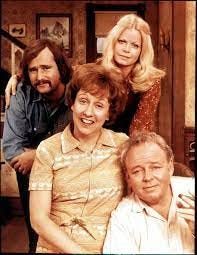
The background: Prof. Williamson and his wife found a house they liked and could afford in northwest suburban Hanover Park. They agreed on a price with the owner. The next day, a woman called and told him, “I live in the block where you are moving, and we don’t want you here.”
“Williamson: ‘Why?’
“Woman: ‘Don’t you know why?’
“Williamson: ‘I can’t imagine why.’
“Woman: ‘Then think about it.’ And she hung up.”
Prof. Williamson has an 11-month-old adopted daughter, Joy. “And Joy is black.”
Neighbors had already confronted the house’s owner, Randy Larson, “and told him he had sold them out, left them holding the bag, betrayed them. Their real estate values (about $35,000 to $45,000 a house) would topple, and their good life would sour, all because of that…eeek…black baby.” (Those house values in 2022 money: $236,250-$303,750)
A little while later, the neighbor from across the street stuck a wooden cross in Larson’s lawn and set it on fire.
“Larson dashed outside and angrily carried the charred cross across the street and dumped it on his neighbor’s lawn.” A wrestling match ensued before breaking up.
Prof. Williamson went to Larson’s house the next day, and ten neighbors quickly showed up to complain.
“They said their main concern was that Joy would lower their real estate values,” Williamson told Mike. There’s another family with an adopted black child nearby, so one neighbor said, “This will double our black population.”
Williamson considered not moving to Hanover Park after all.
“We didn’t want to live in a neighborhood of mental and moral midgets,” he said. But then Williamson realized he needed to stand up for his principles, as he tells his students.
So Prof. Williamson’s family was going to move to the 5800 block of Farmington Ct. in Hanover Park anyway.
“It wouldn’t surprise me if real estate values do go down,” Mike concludes. “If word gets out that there are that many yahoos in one block, who would want to move in?”
As we here all know, weekends could be sad for a Daily News family because Mike Royko wasn’t in the Daily News’ single weekend edition. So we look for Mike elsewhere on weekends.
Looking for Mike in other newspapers, Installment #2
What’s Mike up to outside the Daily News? Last week we looked at Mike in the Tribune, from his first mention there in 1965, through 1966. Today, let’s switch to the Defender. But since this is already quite a lengthy installment, we’ll just look at something quick: an ad from October 23, 1967.
By the way, this feature is no substitute for reading Mike’s full columns. He’s best appreciated in the clear, concise, unbroken original version. Mike already trimmed the verbal fat, so he doesn’t need to be summarized Reader’s Digest-style, either. Our purpose here is to give you some good quotes from the original columns, but especially to give the historic and pop culture context that Mike’s original readers brought to his work. You can’t get the inside jokes if you don’t know the references. Plus, many columns didn’t make it into the collections, so unless you dive into microfilm, there are some columns covered here you will never read elsewhere. If you don’t own any of Mike’s books, maybe start with “One More Time,” a selection covering Mike’s entire career and including a foreword by Studs Terkel and commentaries by Lois Wille.
Do you dig spending some time in 1972? If you came to MIKE ROYKO 50 YEARS AGO TODAY from social media, you may not know it’s part of the book being serialized here, one chapter per month: “Roseland, Chicago: 1972.” It’s the story of Steve Bertolucci, 10-year-old Roselander in 1972, and what becomes of him. Check it out here.
To get MIKE ROYKO 50 YEARS AGO TODAY in your mailbox weekly along with THIS CRAZY DAY IN 1972 and new chapters of the book—
SUBSCRIBE FOR FREE!

